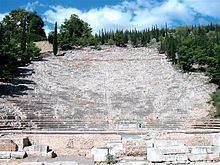 | ||
Argos theater 2 video 2011 09 16 11 25 21 mp4
Significance
Considered one of the largest ancient Greek theaters, the theater at Argos has a very long history of evolving from a small archaic theater at the base of a rocky slope in the ancient city's agora, to a monumental theater holding 20,000 spectators; a pride of Hadrian. It is possible that this theater, and the Roman odeon, where known by Aeschylus, Sophocles, Euripides, and Aristophanes. With the Nafplio bay to the south, and the city of Argos as a backdrop, this theater has provided enormous insight into the importance of theater in the Peloponnese and the development of theater as a venue for 1000 years of Greek history.
Contents
Discovery
With an excavation that began in 1892, two theaters were unearthed about 100 meters from Argos in the city's ancient agora. Initially, the smaller of the two theaters was found and dated to the 3rd of 4th century BC.This archaic theater that was later converted into an odeon; when population demand required a bigger theater. A larger Hellenistic theater, dated to the late 4th century (Tomlinson), was found just to the North and excavated. These sites are believed to have been buried for 1,400 years before being discovered.(Princeton Encyclopedia of Classical Sites)
Theater
The Hellenistic theater at Argos is cut into the hillside of the Larisa with 90 steps up a steep incline forming a narrow rectilinear cavia. Among the largest theaters in Greece, it held about 20,000 spectators and is divided by two landings into three horizontal sections. Staircases further divide the cavia into four cunei, corresponding to the tribes of Argos.(Psychogiou) British archaeologist R.A. Tomlinson describes the positions of the steps as not conforming to any regular plan, and the blocks are consequently of varying sizes. A high wall was erected to prevent unauthorized access into the theatron and may have helped the acoustics, but it is said the sound quality is still very good today.
Around 120 CE, both theaters were renovated in the Roman style. It was around this time that the smaller of the theaters was converted to an odeon, and the Hellenistic theater became Greco-Roman. Containing one of only two examples of a circular orchestra, the other is at Epidauros, the Romans constructed a proskenion that covered part of the orchestra with a hyposkenion below it. The cavia doesn't show evidence of renovation so it can be assumed that they remain original. (Lavy)
Another notable feature is the Charonian stairway. Actually more like a tunnel, the stairway lead underground from the backstage to the orchestra pit and is presumed to be used by actors to "sudden appear" among the actors in play. Other reports suggest these tunnels were too short and narrow to operate effectively for actors, especially actors in costume. In 1988, archaeologists revealed a full circle orchestra bounded by stone like the theater of Epidauros. "Argos and Epidauros are the only two theaters proven to have this orchestral feature.(Ashby)
